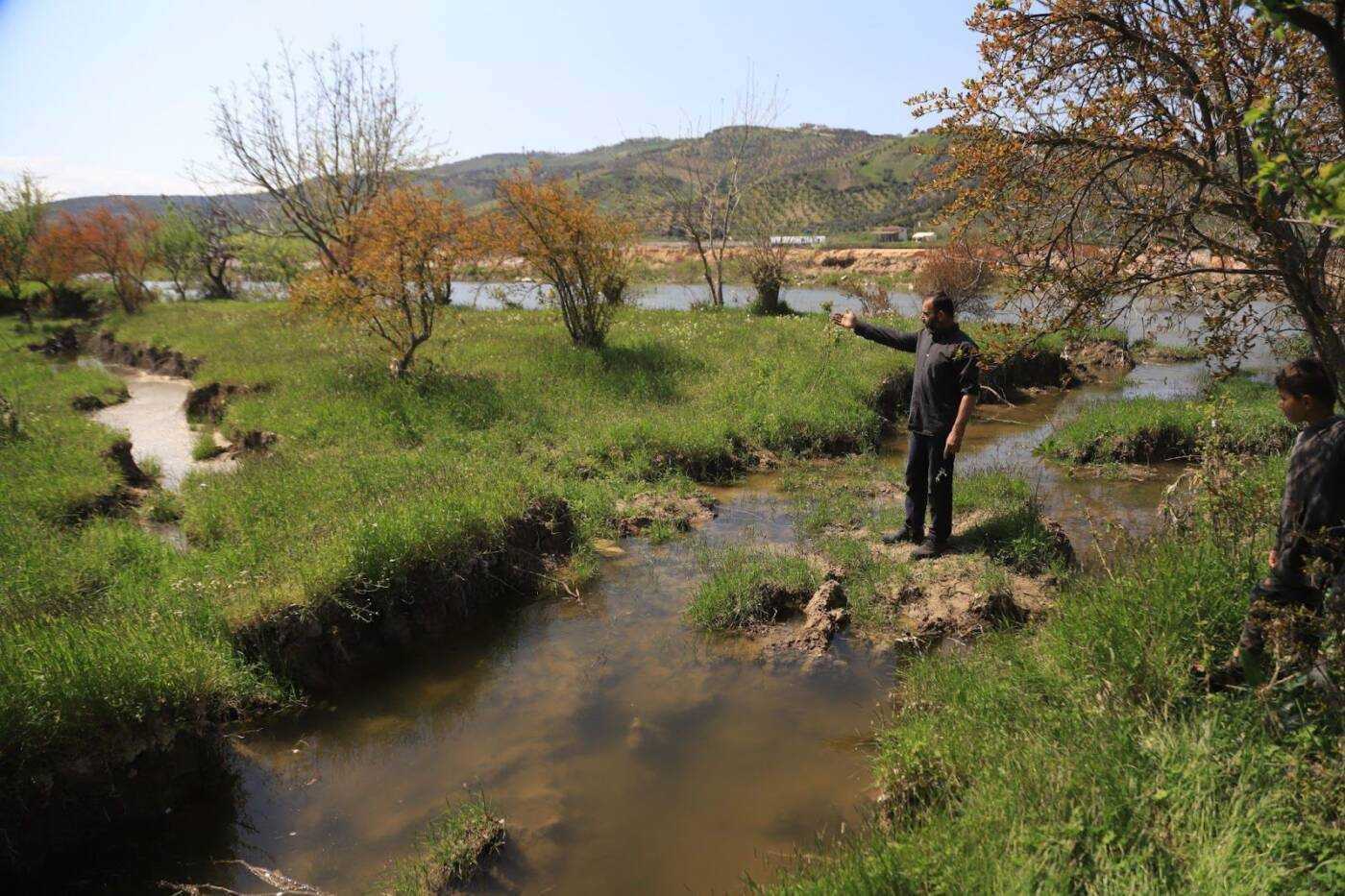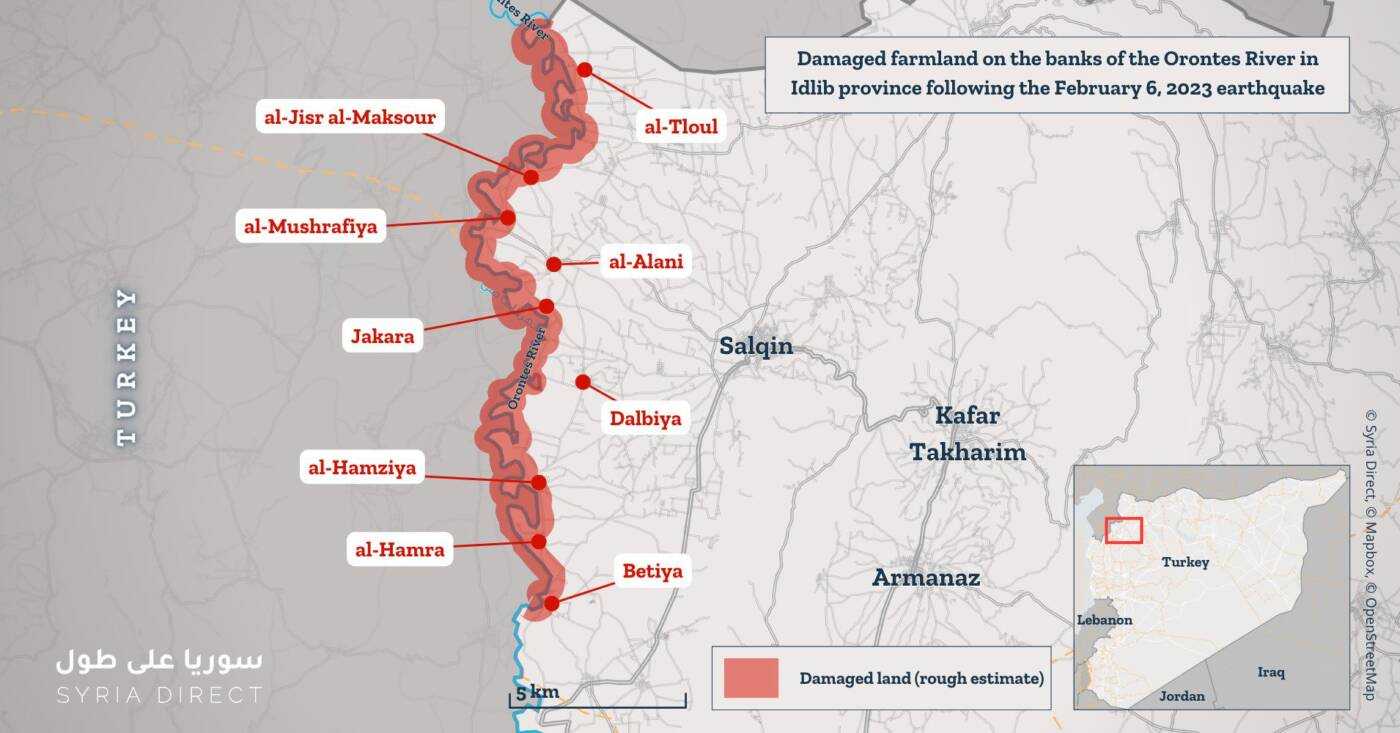Flooded soil, cracked earth: Farmers face earthquake damage along the Orontes River
Cracks, soil displacement and flooding due to the February 6 earthquake severely damaged farmland along a 55-kilometer stretch of the Orontes River in Syria’s northwestern Idlib province, wiping out farmers’ crops.
19 April 2023
IDLIB — Abu Muhammad has lost around 80 percent of his fruit trees since the February 6 earthquake struck northern Syria and southern Turkey. When the earth shook, cracks opened up in his 10 dunums of land in al-Alani, a village on the banks of the Orontes River in Idlib province.
The cracks damaged tree roots and flooded part of Abu Muhammad’s land with water from the nearby river, causing the 57-year-old farmer to lose his entire crop for the year. “Each crack ranges from two to six meters wide,” he told Syria Direct.
Vast areas of agricultural land in northwestern Syria—especially along the banks of the Orontes River that runs between Idlib province and Turkey—were damaged as a result of the February 6 earthquake. In the Hayat Tahrir al-Sham (HTS)-controlled Idlib countryside, the villages of al-Tloul, al-Jisr al-Maksour, al-Mushrafiya, al-Alani, Jakara, Dalbiya, al-Hamziya, al-Hamra and Betiya were all impacted.
The earthquake, and the aftershocks that followed, caused cracks and large craters to form in farmland. Volcanic sand rose up out of the earth. And the Orontes River—a 571-kilometer-long waterway that flows northward through territory controlled by the Turkish-backed opposition and HTS in northwestern Syria—flooded in the days following the quake.
Land lying along a 55-kilometer stretch of the Orontes was damaged, Saleh al-Daryai, Director of Water Resources at the HTS-backed Salvation Government’s Ministry of Agriculture and Irrigation, told Syria Direct. The Salvation Government is the de facto body administering Idlib and parts of the western Aleppo countryside and Latakia.
Ahmad al-Kawan, the Salvation Government’s Deputy Ministry of Agriculture, said cracks and fissures were concentrated along both sides of the river. “Some 20,000 dunums of land were impacted,” he told Syria Direct.

The al-Aswad family’s land was damaged by the February 6, 2023 earthquake in al-Alani village, near the Idlib countryside town of Salqin, 27/3/2023 (Abd Almajed Alkarh/Syria Direct)
Changing geography
More than two months after the earthquake, Abu Muhammad can only enter his land on foot. The road leading to it was damaged by cracks and a change in the level of the soil. Some parts of his land have fallen by up to two meters, while others have risen by around one meter. As a result, he cannot use his land “by plowing it or bringing machinery in,” he said.
These changes were also what damaged his fruit trees. “Most of them dried up,” he said. “Their roots ruptured due to the different levels of the soil, killing them.”
Geologist Thabit Kasha attributed these environmental phenomena to faults, “cracks in the ground accompanied by displacements between two blocks, causing the roots of the trees to come out [of the ground] and dry up.” The distance of separation or displacement between the two blocks on either side of the fault due to the earthquake was an average of four meters, he explained. This caused “rises and falls in the level of the soil, sufficient distances to put an end to the agricultural crops this season” on the land that was damaged.
Fissures and displacements have changed the geography of the affected area. In some areas, the water level of the Orontes rose, while in others it receded, with major impacts on farmland adjacent to the river. Where the level of the soil became the same as that of the river, the land flooded, drowning crops, as in the case of Abu Muhammad’s land, some of which is still flooded today.
Read more: How did the earthquake affect Syria’s dams and rivers?
“The winter crops were completely damaged,” al-Kawan said, not to mention “the irrigation stations in the area going out of service, because they were destroyed or because the course of the river changed,” he said. The earthquake also “changed the position of private and public pumps due to the altered course of the river.”
As part of its response, the Salvation Government’s Ministry of Agriculture and Irrigation has worked to “repair the earthen embankment dam that collapsed because of the earthquake,” al-Kawan added. As for the trees near the river, “some areas need terraces to be established so farmers can plow their land.”
Because the earthquake damaged portions of the concrete barrier separating Syria from Turkey that Ankara constructed years ago to prevent smuggling into its territory, “new cross-border smuggling points were formed,” Abu Muhammad said. He is worried about his land, anxious that “the Turks could annex it to their territory to plug the cross-border smuggling gaps,” he said, adding that his fears were bolstered “by previous events.”
Volcanic sands
In some land damaged by the earthquake, salty volcanic sands were cast to the surface through large cracks, damaging plants, farmer Muhannad al-Aswad said, including his own.
“This sand prevents the trees from absorbing what they need from the soil, causing them to dry out and die,” he added. “Even the grass dried up and died because of the sand.”
Geologist Kasha said “the volcanic sand ejected by the earth came up from depths ranging from 200 to 300 meters.” He stressed that the soil in areas affected by these sands should be tested to verify whether it is suitable for cultivation or not, because they “break up and ruin the soil.”
If “it is proven that there is quartz sand, the land will be completely unsuitable for agriculture, meaning the farmer will have to completely replace the soil to reclaim the land,” Kasha explained.
Crop loss
Agriculture is the main source of income for many Idlib residents, including Abu Muhammad. His land is planted with various types of crops and fruit trees, including greengage plums, peaches and nectarines.
Farming is “my only source of livelihood,” Abu Muhammad said. His family relies on the seasons year-round, “but this season, we lost our crops completely.”
Farmland’s proximity to the river was once a blessing, but has become a curse. “The damage was concentrated on areas adjacent to the river,” al-Kawan explained. “Land further away did not experience similar cracking, but rather the temporary damage of a rise in the water level.”
To support affected farmers, the Salvation Government has directed the owners of land without trees to “plant it with cotton, with the seeds and agricultural supplies to be provided under an in-kind loan from the Salvation Government,” al-Kawan said. Cotton was chosen because it is “a strategic, economically feasible crop” that “the government and the Ministry of Agriculture and Irrigation introduced as part of its plans to improve farmers’ income and diversify agriculture in the area.”
The Salvation Government aims to “benefit from cotton, which in the future can contribute to establishing spinning factories and creating jobs, as well as extracting oil from its seeds,” al-Kawan said. “The rehabilitation of the Ain al-Zarqa irrigation project can significantly contribute to the success of these crops,” he added.
Reclamation deferred
There are ways for al-Aswad to reclaim his land, but he does not plan to do so, “because of the exorbitant cost.” He has decided to leave his land as it is now, which also means “additional costs in drawing water, because of the change in the water level of the Orontes,” he told Syria Direct.
For al-Aswad, irrigating his land used to only entail “opening the water channel feeding the land, which was at the level of the river.” Now, “I will have to draw the water through solar-powered pumps,” he said.
Abu Muhammad estimated the cost of installing and operating a solar-powered pumping system at between $1,200 and $1,500. He also needs to “transport new soil to my land, to level it.” To do so, he estimated he needs “1,000-2,000 trucks of red soil that is suitable for farming, to get my land back to its position before the earthquake, at a cost of around $3,000.”
In any event, reclaiming land damaged by the earthquake would be a premature step, as “the tectonic plates have yet to stabilize,” geologist al-Kasha said. He noted that farmers should wait “until the land settles and the plates return to how they were, and level the land after they stabilize.”
Abu Muhammad hopes to reclaim his land as soon as he can, but it is not an option this year. “There’s not enough money,” he said.
This report was originally published in Arabic and translated into English by Mateo Nelson.







